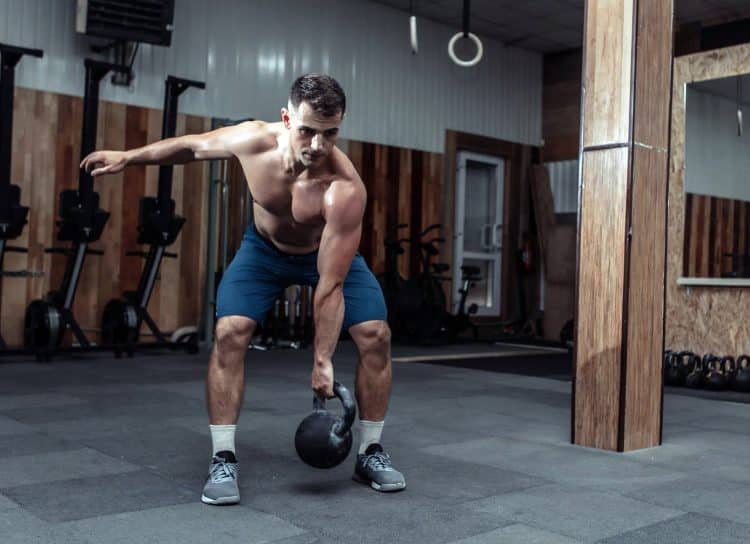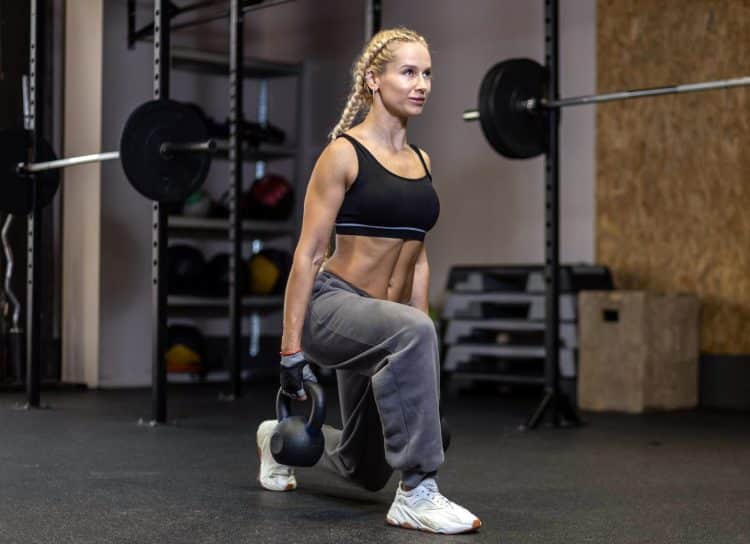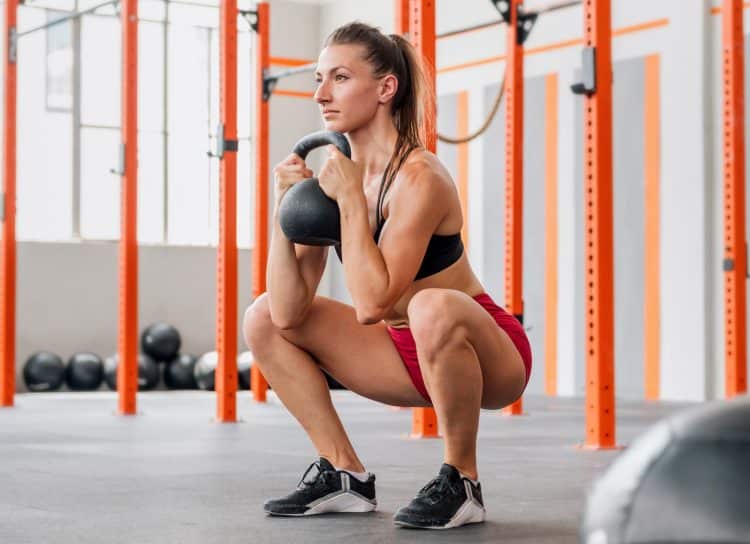When it comes to working out, there are many variables. Should you use a high or low rep range? Is a fast or slow training tempo best? Should you focus on compound or isolation exercises? Your training goals will largely determine the answers to these questions.
If your goal is to develop a beach-ready muscular physique, then training individual muscle groups is the way to go. But if you want to build a leaner, fitter, more athletic body that you can use in the real world, you should incorporate functional fitness into your workouts.
When it comes to functional fitness exercises, kettlebells are an excellent choice. Kettlebells challenge your body in ways that replicate real-world movements to improve your functional strength, stability, and coordination. In this article, we lay out eight fantastic kettlebell functional fitness exercises and then program them into three super-effective workouts you can alternate between to build a functionally fit physique.
What is Functional Muscle Training?

Workouts consisting of exercises that stimulate multiple muscles rather than isolating particular muscles are called functional training workouts. These types of exercises force your muscles to work together and move through multiple joints. This improves neuromuscular control and coordination.
Functional muscle training enhances our capacity to carry out everyday tasks like getting out of a chair or carrying a sack of potatoes.
Any exercise that will help you operate better by strengthening your heart, lungs, or muscles can be categorized as a functional exercise. However, there is a range of functionality for how effective an activity will be.
Exercises that isolate muscles, like the seated leg extension, are at the lowest end of that spectrum. Movements like the squat that imitate our everyday actions are at the other end of the spectrum. We all squat down frequently throughout the day, whether it’s to use the restroom or sit in a chair. Exercises like this that mimic practical movement patterns will improve a person’s flexibility, balance, and coordination.
Enhanced Movement Patterns
Rather than being based on isolated muscle movement, functional training is based on movement patterns. That’s the way that our bodies were made to work. We operate best when we are in an upright position with our feet set on the ground.

In this position, we can execute the following movement patterns:
- Squat
- Hinge
- Lunge
- Overhead Press
- Chest Press
- Core Rotation
Functional movements that mimic these movement patterns should form the basis of any functional fitness workouts. Doing such exercises will improve your strength and performance through the movement pattern you are performing.
Why Use Kettlebells for Functional Fitness?
Kettlebells have come out of the corners of the gym in recent years and entered center stage. That’s because people have become educated on how these strangely shaped weights can improve their workouts. They are especially good for functional training. Here are three reasons why kettlebells deserve a key role in your functional fitness program:
Offset Center of Gravity
The offset center of gravity of the weight is one of the key characteristics distinguishing kettlebells from dumbbells. That’s because when you grab a kettlebell’s handle, its center of gravity is about 6 to 8 inches away from your hand. That makes the weight harder to handle.
This is why every exercise you perform, from standard strength exercises to more difficult kettlebell moves like swings, calls for precise technique and greater muscle stimulation than you can get with dumbbells.
Greater Core Involvement
The instability of a kettlebell means that your core muscles have to be constantly working to maintain your posture and balance. You need to keep your core tight and engaged far more than if you were using a barbell or dumbbells. This core engagement will strengthen your abs, erector spinae, obliques, and intercostals.
Improved Athleticism
Developing your grip strength is one of the key benefits of including kettlebells in your workout program. That’s because the handle thickness and weight displacement require your fingers, hands, and forearms to provide perfect control.
Kettlebell training will also improve your cardio endurance. Most kettlebell exercises are compound, multi-joint moves that require a lot of energy to complete. They’ll tax your heart and lungs as they demand more oxygen. As a result, your muscular and cardiovascular endurance will both increase.
Dynamic kettlebell exercises like swings, snatches, and cleans develop explosive strength. This is an essential requirement for athletes, whether they’re smashing into an opponent on the football field or scrapping for a rebound on a basketball court.
8 Key Kettlebell Moves
Here are the fundamental kettlebell exercises that should feature in functional fitness workouts:
1. Kettlebell Swing
The kettlebell swing burns a ton of calories as it helps develop explosive power. Power largely emanates from the ability to execute a strong hip thrust, which is the key motion involved in this exercise.
Muscles Worked:
- Glutes
- Hamstrings
- Quadriceps
- Core
- Back
- Shoulders
Step-by-Step Guide:
- Stand with your feet shoulder-width apart, with your weight on your heels.
- Rest the kettlebell on the floor between your feet.
- Look down at the ground six feet in front of you.
- Sit back into your hips and reach down to grab the handle with both hands in an overhand grip.
- Swing the bell behind you, then aggressively snap your hips forward as you stand up. As you do this, extend your spine and squeeze your butt.
- Bring your arms up to chest level.
- Immediately return to the bottom hike position and move into the next rep.
2. Goblet Squat
The kettlebell goblet squat helps you to maintain an upright stance by placing the weight in front of your body. To keep the weight centered over your feet, you have to keep your core tight, your lower back pulled in, and your chest up.
Muscles Worked:
- Quadriceps
- Glutes
- Hamstrings
- Core
Step-by-Step Guide:
- Stand with your feet shoulder-width apart with your toes slightly pointed outward.
- Hold a kettlebell with both hands hard up against your chest.
- Hinge at the hips to go down into a full squat position, maintaining a neutral spine and keeping your chest up.
- Push the heels into the floor to come back to an upright position.
3. Roll Up, Roll Down
The roll up, roll down is a dynamic, explosive exercise that combines hip and torso extension with multiplanar movement and ballistic strength. Start with a lighter kettlebell until you get comfortable with the actions involved.
Muscles Worked:
- Abdominals
- Lower back
- Hip flexors
- Shoulders
- Forearms
Step-by-Step Guide:
- Stand with your feet shoulder-width apart in front of an exercise mat. Hold a kettlebell at arm’s length in front of you with both hands.
- Hinge at the hips to descend into a deep squat.
- Continue going down until your butt is sitting on the mat.
- Roll back as you bring the weight up and over your head.
- Now reverse the direction to roll back forward as you bring the weight back overhead and down.
- Use the forward momentum to drive yourself back up to a standing position.
4. Two-Handed Overhead Squat
The overhead kettlebell squat fully engages the back extensor and scapular muscles while also working the lower body. That is going to improve your performance of propulsions movements like sprinting, kicking, jumping, or running.
The overhead squat is a challenging exercise that requires quite a lot of balance and coordination. I recommend working up to it by starting with bodyweight squats with your hands extended overhead. Then advance to doing the exercise with a single kettlebell held with both hands overhead. Only when you’re comfortable with that exercise should you advance to the two-handed overhead squat.
Muscles Worked:
- Quadriceps
- Glutes
- Hamstrings
- Core
- Shoulders
- Triceps
- Forearms
Step-By-Step Guide:
- Stand with your feet shoulder-width apart and slightly turned out and a pair of kettlebells extended overhead in a lockout position. Keep your arms close to your head and your palms facing forward.
- Maintaining an upright body and neutral spine, hinge at the hips to lower to a full squat position. Keep your arms locked out throughout the entire motion.
- Push through your heels to return to the start position.
5. Overhead Walking Lunge
This exercise represents the ideal functional lower-body exercise. That’s because it combines flexion, extension, and propulsion all in one dynamic movement. Then there’s the overhead part of the movement, which improves posture and increases core stability. Moving forward with an asymmetrical load also strongly engages the obliques.
Muscles Worked:
- Quadriceps
- Glutes
- Hamstrings
- Core
- Shoulders
- Triceps
- Forearms
Step-by-Step Guide:
- Stand with your feet shoulder-width apart and a kettlebell held in each arm at your sides. Maintain an upright posture with your chest up and core tight.
- Bring your right arm up above your head, locking out the elbow. The left arm should remain at your side.
- Take a large step forward with your left leg and lunge down to bring the rear knee toward the floor.
- Now follow through with the right leg to take another forward step.
- Continue this forward motion for five steps, then turn around and return to the start position.
- On the next set, raise your left arm overhead.
6. Squat & Press
The squat and press is a great functional exercise that forces your lower body, core, and upper body to work together to execute the movement. If you’re a rugby player, a martial artist, a basketballer, or a track athlete, this exercise is an absolute must to boost your functional fitness.
Muscles Worked:
- Quadriceps
- Glutes
- Hamstrings
- Core
- Shoulders
- Triceps
- Forearms
Step-by-Step Guide:
- Stand with your feet shoulder-width apart and a kettlebell in your right hand at your side. Another kettlebell should be on the floor on the inside of your left foot.
- Now raise your right arm overhead and lock out your elbow.
- Turn both feet to the left and look up at the kettlebell above your head.
- Keeping your torso facing forward, press your right hip back as you lean down to grab the other kettlebell with your left hand.
- Come back to an upright position. Now your right arm will still be above your head with your left arm at your side.
- Perform all your reps on one side, then repeat with the left arm extended overhead.
7. Kettlebell Deadlift
While the kettlebell deadlift won’t allow you to lift as much weight as a standard barbell version of the exercise, it does allow you to achieve a fuller range of movement. The kettlebell can travel well beyond the tibiae, towards the heels, whereas the barbell presses against and stops at the tibiae. This allows you to extend the hip extensor chain more effectively.
Muscles Worked:
- Glutes
- Hamstrings
- Quadriceps
- Core
- Back
- Forearms
Step-by-Step Guide:
- With your legs bent, sit back into a half-squat as though you were going to jump up. The chest should be up with the shoulder blades squeezed together. Your back should be naturally arched. The kettlebell should be held with your arms extended and level with your heels.
- Extend the pelvis up and forward while keeping the scapulae together until you are upright.
- Slowly return to the half-squat position so that the kettlebells end up at floor level. Maintain an upright posture with natural back curvature.
8. Renegade Row
The renegade row is a combination of a plank and a row. As such, it does a great job of working both the lats and the core muscles. Every time you bring an arm off the floor, you will engage the entire core area as it balances, stabilizes, and supports your body. This is an all-encompassing exercise that serves as the foundation for athletic training in all activities that place significant stress on the core, including combat sports, martial arts, wrestling, judo, rugby, American football, tennis, and baseball.
Muscle worked:
- Latissimus dorsi
- Rhomboids
- Trapezius
- Biceps
- Triceps
- Shoulders
- Core
Step-by-Step Guide:
- Get down in the high push-up position with kettlebells in your hands. Your feet should be shoulder-width apart, arms fully extended, and shoulders directly above the kettlebells.
- Row the right hand kettlebell up toward your ribcage.
- Lower back to the start position under control.
- Repeat with the left hand kettlebell.
- Continue alternating sides to complete your rep count.
Functional Fitness Kettlebell Workouts
Now that we know how to do the eight key fundamental kettlebell exercises for functional fitness, let’s put them together in the form of three workouts that you can alternate over the course of your workout week.
Workout A: Kettlebell HIIT Functional Fitness Circuit
Method: Perform each exercise for 40 seconds. Then rest for exactly 20 seconds before beginning the next exercise. Complete all eight exercises in eight minutes, then rest for exactly two minutes. Work up to doing four rounds of this HIIT circuit.
Warm-Up: Three minutes of medium intensity on a rowing machine.
- Kettlebell Swing
- Goblet Squat
- Roll Up, Roll Down
- Two-Handed Overhead Squat
- Overhead Walking Lunge
- Squat & Press
- Kettlebell Deadlift
- Renegade Row
Cool-Down: Three minutes of medium intensity on a rowing machine.
Workout B: EMOM Kettlebell Functional Fitness Workout

EMOM stands for every minute on the minute. It involves starting an exercise at the start of every new minute and then resting for any remaining time within the minute once your reps are complete. So, you begin by doing 15 reps of kettlebell swings, which takes 48 seconds. That leaves you with 12 seconds to recover before going into the next exercise when 60 seconds is up. You continue this pattern to complete all five exercises.
At the end of the round, rest for two minutes. Work up to completing eight rounds.
Warm-Up: Three minutes of medium intensity on a rowing machine.
- Kettlebell Swing: 15 reps
- Goblet Squat: 10 reps
- Two-Handed Overhead Squat: 8 reps
- Renegade Row: 6 reps (per arm)
- Squat & Press: 5 reps
Cool-Down: Three minutes of medium intensity on a rowing machine.
Workout C: Straight Sets Kettlebell Functional Fitness Workout
You should rest 45-60 seconds between each set for this straight-set workout.
Warm-Up: Three minutes of medium intensity on a rowing machine.
- Kettlebell Deadlift: 3 sets of 15 reps
- Kettlebell Swings: 3 sets of 20 reps
- Renegade Row: 3 sets of 12 reps (each arm)
- Squat & Press: 3 sets of 12 reps
- Roll Up, Roll Down: 3 sets of 8 reps
- Overhead Walking Lunge: 3 sets of 10 forward steps
Cool-Down: Three minutes of medium intensity on a rowing machine.
Wrap Up
Kettlebells are perfect for functional fitness. You now have a list of eight of the best functional fitness kettlebell exercises, along with three challenging workouts to effectively work your entire body. Take the time to learn how to do the exercises well, and then add these functional fitness workouts to your schedule. Begin with one per week, gradually increasing to three sessions, spaced at least a day apart. You’ll soon be rewarded with a healthier, functional, and athletic body.
